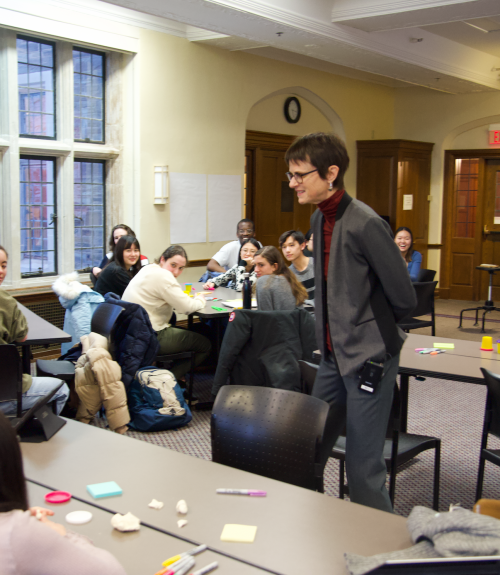Dr. Virginia Rath, a scientist, design research consultant and serial entrepreneur, led Cornell students in a workshop on Jan. 29, encouraging attendants to employ design thinking skills to innovate solutions.
During the workshop, students practiced qualitative approaches to design thinking such as user observations and ethnographic interviews to help them understand stakeholders.
Innovation is about “deeply understanding customers to find their unmet, unarticulated needs,” according to Rath. In the workshop, Rath outlined the design thinking process from analysis — collecting data, interviewing people — to synthesis, adding that finding unmet needs can be a paradoxical venture.
Rath urged students to observe customers in the context in which they use a product, service or solution, and then to frame, and reframe, the problem that needs to be solved. After clearly understanding the problem, the students were told to imagine and design a solution, before finally making a prototype and experimenting.
The workshop was provided by the Milstein Program. Students selected for the program earn a liberal arts education on Cornell’s Ithaca campus and combine their learning with two summers spent at the Cornell Tech campus on Roosevelt Island. The program integrates liberal arts studies with technology and the digital world.
Workshops like this one give students a diverse set of skills to tackle today’s most challenging solutions. Through community-based projects, students are asked to practice empathy, challenge assumptions and redefine problems in an attempt to identify alternative strategies.
In one activity, students paired up and created a new way to eat their favorite food using a Play Doh model. In order to complete this task, the student had to conduct an interview. Rath explained that an ethnographic interview should be an open-ended conversation exploring the needs, emotions and aspirations of the person being interviewed.
The students then innovated impactful and creative solutions, such as a flat spoon for dipping dumplings in sauce without ripping the dumplings apart, or a portable ice cream container that keeps the treat cold on the go.
“Using Play Doh to implement the design thinking process was simple and fun and allowed us to practice and internalize this approach to problem solving so we could use it with our community projects,” said Geoff Brann ’23.
Rath explained that needs are “gaps within a system of use, usability and meaning” — which all play a different role in understanding the client or user. Customers might ask, for example, “What is it for?” and “What does It say about me?” Asking these questions and understanding their answers is essential to fulfilling the user’s needs in all aspects.
Milstein students will employ these new strategies during the school year in their project work with community partners and hopefully in their summer sessions at Cornell Tech on Roosevelt Island.




